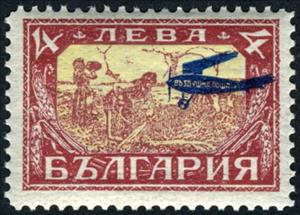Stamp: No. 191 with Imprint (Bulgaria 1927)
No. 191 with Imprint (Bulgaria 1927)
07 November (Bulgaria ) within release Definitives with Imprint of an Aircraft goes into circulation Stamp No. 191 with Imprint face value 4 Bulgarian lev
| Stamp No. 191 with Imprint in catalogues | |
|---|---|
| Michel: | Mi:BG 208 |
Stamp is square format.
Imprint blueAlso in the issue Definitives with Imprint of an Aircraft:
- Stamp - No. 199 with Imprint face value 1;
- Stamp - No. 191 with Imprint face value 4;
Stamp No. 191 with Imprint it reflects the thematic directions:
Agriculture is the cultivation and breeding of animals, plants and fungi for food, fiber, biofuel, medicinal plants and other products used to sustain and enhance human life.[1] Agriculture was the key development in the rise of sedentary human civilization, whereby farming of domesticated species created food surpluses that nurtured the development of civilization. The study of agriculture is known as agricultural science. The history of agriculture dates back thousands of years, and its development has been driven and defined by greatly different climates, cultures, and technologies. Industrial agriculture based on large-scale monoculture farming has become the dominant agricultural methodology.
Aviation is the practical aspect or art of aeronautics, being the design, development, production, operation and use of aircraft, especially heavier than air aircraft. The word aviation was coined by French writer and former naval officer Gabriel La Landelle in 1863, from the verb avier (synonymous flying), itself derived from the Latin word avis ("bird") and the suffix -ation.
An aircraft is a machine that is able to fly by gaining support from the air. It counters the force of gravity by using either static lift or by using the dynamic lift of an airfoil, or in a few cases the downward thrust from jet engines. The human activity that surrounds aircraft is called aviation. Crewed aircraft are flown by an onboard pilot, but unmanned aerial vehicles may be remotely controlled or self-controlled by onboard computers. Aircraft may be classified by different criteria, such as lift type, aircraft propulsion, usage and others.



